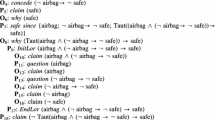Abstract
This paper presents an alternative to the ‘speech acts with STRIPS’ approach to implementing dialogue a fully implemented AI planner which generates and analyses the semantics of utterances using a single linguistic act for all contexts. Using this act, the planner can model problematic conversational situations, including felicitous and infelicitous instances of bluffing, lying, sarcasm, and stating the obvious. The act has negligible effects, and its precondition can always be proved. ‘Speaker maxims’ enable the speaker to plan to deceive, as well as to generate implicatures, while ‘hearer maxims’ enable the hearer to recognise deceptions, and interpret implicatures. The planner proceeds by achieving parts of the constructive proof of a goal. It incorporates an epistemic theorem prover, which embodies a deduction model of belief, and a constructive logic.
Similar content being viewed by others
References
Allen, J.F. & Perrault, C.R. (1980). Analyzing Intention in Utterances.Artificial Intelligence 15:143–178.
Appelt, D.E. (1985). Planning English Referring Expressions.Artificial Intelligence 26: 1–33.
Austin, J.L. (1962). How to Do Things with Words,2nd edn.Oxford: OUP.
Blum, A.L. & Furst, M.L. (1997). Fast Planning Through Planning Graph Analysis. Proceedings of the 14th International Joint Conference on Artificial Intelligence (IJ-CAI),1995,1636-1642.Also in Artificial Intelligence 90:281–300.
Bonet, B. & Geffner, H. (2000). HSP:Heuristic Search Planner.AI Magazine 21 (2): Entry at the AIPS-98 Planning Competition,Pittsburgh 6 98.
Bruce, B.C. (1975). Generation as a Social Action.In Nash-Webber,B.L. & Schank, R.C.(eds.)Theoretical Issues in Natural Language Processing,74–77.Cambridge, MA:Ass.for Computational Linguistics.
Bunt, H. (2000). Dialogue and Context Specification.In Bunt, H. & Black, W.(eds.) Abduction,Belief and Context in Dialogue:Studies in Computational Pragmatics,81–150.Philadelphia,PA: John Benjamins.
Cohen, P.R. & Levesque, H.J. (1990). Rational Interaction as the Basis for Communication.In Cohen, P.R., Morgan, J. & Pollack, M.E.(eds.)Intentions in Communication,221–255.Cambridge,MA: MIT.
Cohen, P.R. & Perrault, C.R. (1979). Elements of a Plan-based Theory of Speech Acts. Cognitive Science 3:177–212.
Fikes, R.E. & Nilsson, N.J. (1971). STRIPS:A New Approach to the Application of Theorem Proving to Problem Solving.Artificial Intelligence 2:189–208.
Gentzen, G. (1935). Investigation into Logical Deduction.In Szabo, M.E.(ed.)The Collected Papers of Gerhard Gentzen,68–131.North-Holland,1969.Originally published as Untersuchungen u¨ber das logische Schliessen,Mathematische Zeit-schrift 39:176-210 and 405-431.
Green, C. (1969). Application of Theorem Proving to Problem Solving.Proc.1st IJCAI, 219–239.
Grice, H.P. (1975). Logic and Conversation.In Cole, P. & Morgan, J.(eds.)Syntax and Semantics,Vol.3:Speech Acts,41–58.New York: Academic Press.
Grosz, B.J. & Sidner, C.L. (1990). Plans for Discourse.In Cohen, P.R., Morgan, J. & Pollack, M.E.(eds.)Intentions in Communication,416–444.Cambridge,MA: MIT.
Heyting, A. (1956).Intuitionism:An Introduction.Amsterdam:North-Holland.
Heyting, A. (1975). Brouwer Collected Works (I ).Amsterdam:North-Holland.
Hintikka, J. (1962). Knowledge and Belief:An Introduction to the Two Notions.New York: Cornell University Press.
Hoffmann, J. & Nebel, B. (2001). The FF Planning System:Fast Plan Generation Through Heuristic Search.Journal of Artificial Intelligence Research 14:253–302.
Konolige, K. (1986). A Deduction Model of Belief.London:Pitman.
Kripke, S. (1963). Semantical Considerations on Modal Logic.Acta Philosophica Fennica 16:83–94.
Lewis, D. (1979). Scorekeeping in a Language Game.Journal of Philosophical Logic 8: 339–359.
McCarthy, J. & Hayes, P.J. (1969). Some Philosophical Problems From the Standpoint of Artificial Intelligence.Machine Intelligence 4:463–502.
Moore, R.C. (1985). A Formal Theory of Knowledge and Action.In Hobbs, J.R. & Moore, R.C.(eds.)Formal Theories of the Common Sense World,319–358.Norwood,NJ:Ablex.
Newell, A. & Simon, H.A. (1963). GPS,A Program that Simulates Human Thought.In Feigenbaum, E.A. & Feldman, J.(eds.)Computers and Thought,279–293.New York: McGraw-Hill.
Newell, A., Shaw, J.C. & Simon, H.A. (1957). Empirical Explorations with the Logic Theory Machine.Proceedings of the Western Joint Computer Conference 15:218–239.
Nguyen, X. & Kambhampati, S. (2001). Reviving Partial Order Planning.Proc.IJCAI, 459–466.
Pollack, M.E. (1990). Plans as Complex Mental Attitudes.In Cohen, P.R., Morgan, J. & Pollack, M.E.(eds.)Intentions in Communication,77–103.Cambridge,MA: MIT.
Ramsay, A. (2000). Speech Act Theory and Epistemic Planning.In Bunt, H. & Black, W.(eds.)Abduction,Belief and Context in Dialogue:Studies in Computational Pragmatics,293–310.Philadelphia,PA: John Benjamins.
Searle, J.R. (1965). What is a Speech Act?In Black, M.(ed.)Philosophy in America, 221–239.Allen and Unwin.
Stalnaker, R. (1972). Pragmatics.Proceedings of the Aristotelian Society 86:153–171.
Thomason, R.H. (1990). Accommodation,Meaning,and Implicature:Interdisciplinary Foundations for Pragmatics.In Cohen, P.R., Morgan, J. & Pollack, M.E.(eds.) Intentions in Communication,325–363.Cambridge,MA: MIT.
Author information
Authors and Affiliations
Rights and permissions
About this article
Cite this article
Deborafield, Allanramsay Sarcasm, Deception, and Stating the Obvious: Planning Dialogue without Speech Acts. Artificial Intelligence Review 22, 149–171 (2004). https://doi.org/10.1023/B:AIRE.0000045504.76256.0d
Issue Date:
DOI: https://doi.org/10.1023/B:AIRE.0000045504.76256.0d




